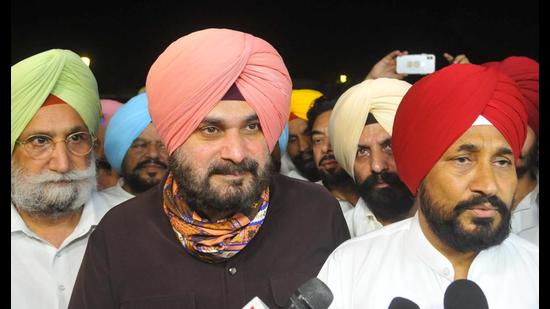How Punjab CM Channi’s assertion in power politics riled Navjot Sidhu
Chief minister Charanjit Singh Channi’s assertion led to Punjab Congress chief Navjot Sidhu’s resignation, plunging the ruling party into a deeper turmoil
Punjab Congress president Navjot Singh Sidhu’s surprise resignation on Tuesday, barely nine weeks after he took over the reins of the faction-torn state unit, was a culmination of a series of behind-the-scenes events that left him peeved since his bête noire Capt Amarinder Singh’s nemesis on September 20. A photo-op bonhomie that Charanjit Singh Channi and Sidhu had publicly exuded soon after the former’s surprise elevation as Punjab’s first Dalit chief minister quickly evaporated, giving way to tussle over power politics. Here are five reasons why 58-year-old mercurial cricketer-turned-politician called it quits, abruptly ending his 68-day innings at the helm and plunging the ruling party into a deeper turmoil.

Though the Congress high command endorsed newly-appointed PCC chief’s choice of Channi as CM after the cloak-and-dagger games that edged out Sidhu’s potential challengers in Sunil Jakhar and Sukhjinder Randhawa, it nixed his opposition to the appointment of Randhawa, a prominent Jat Sikh face, as deputy chief minister. Sidhu, also a Jat Sikh, viewed the Majha heavyweight’s elevation as a threat to his chief ministerial ambitions in the 2022 assembly poll sweepstakes. Sidhu was miffed at being overruled on Randhawa, who had made a common cause with him in the rebellion against Amarinder.
Much to Sidhu’s consternation, he had a limited say in the formation of the 15-minister cabinet on Sunday. The cabinet had an unmistakable stamp of Rahul Gandhi who retained several of the Amarinder loyalists — a damage-limiting move to deny the sulking former chief minister a chance to emerge as a rallying figure of discontented party leaders. Sidhu had pressed for a new-look cabinet to jettison anti-incumbency of the Amarinder era. But, the high command didn’t buy into that.
What added insult to Sidhu’s injury was the return of Rana Gurjit Singh, a sugar baron-MLA from Kapurthala, to the cabinet four years after he had to quit the Capt Amarinder Singh-led ministry over allegations of his collusion in the sand auction scam. Though Rana was absolved by a commission of inquiry, Sidhu doggedly opposed his comeback on “ethical grounds”, but the high command overlooked his objections and that of eight party MLAs from the Doaba region who, hours before the swearing-in, vainly raked up Rana’s tainted past. That raised Sidhu’s hackles as he saw this as “compromise” on party’s much-touted anti-corruption plank.
Sidhu was also miffed over Channi’s assertion — undoubtedly, with the high command’s backing — in the allocation of ministerial portfolios. On Tuesday, Channi gave the powerful home department to Randhawa who will now directly supervise the 2015 sacrilege and police firing cases, and drug mafia investigations. An action on the electorally-sensitive issues, as the Channi government has avowedly promised, could potentially bolster Randhawa’s political standing which apparently doesn’t sit well in Sidhu’s scheme of things.
What came as the last straw in their rapidly fraying ties was Channi assertively exercising the high command-mandated leeway and ignoring Sidhu’s push for the appointment of Siddhartha Chattopadhayaya as director general of police and DS Patwalia as advocate general. The chief minister, in a deft move to shake off the perception about PCC chief calling the shots in his government, played hardball on Sidhu’s intense lobbying, and went ahead with his own choices, appointing Iqbal Preet Singh Sahota and APS Deol for the top police and law office posts, respectively. That galled Sidhu and became the last catalyst in his doing what he has done many a time before: calling it quits on “high principles”.





